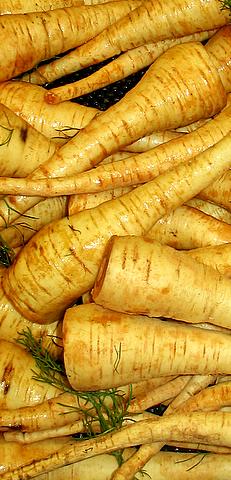- Parsnip
Taxobox
name = Parsnip

image_width = 250px
image_caption = A selection of parsnips
regnum =Plant ae
divisio = Magnoliophyta
classis =Magnoliopsida
ordo =Apiales
familia =Apiaceae
genus = "Pastinaca "
species = "P. sativa"
binomial = "Pastinaca sativa"
binomial_authority = L. [cite web
url=http://www.ars-grin.gov/cgi-bin/npgs/html/taxon.pl?27018
title=Pastinaca sativa information from NPGS/GRIN
publisher=www.ars-grin.gov
accessdate=2008-03-02
last=
first=]The parsnip ("Pastinaca sativa") is a
root vegetable related to thecarrot . Parsnips resemble carrots, but are paler than most of them and have a stronger flavor. Like carrots, parsnips are native to Eurasia and have been eaten there since ancient times. Zohary and Hopf note that the archeological evidence for the cultivation of the parsnip is “still rather limited,” and that Greek and Roman literary sources are a major source about its early use, but warn "there are some difficulties in distinguishing between parsnip and carrot (which, in Roman times, were white or purple) in classical writings since both vegetables seem to have been sometimes called "pastinaca" yet each vegetable appears to be well under cultivation in Roman times." [Daniel Zohary and Maria Hopf, "Domestication of plants in the Old World", third edition (Oxford: University Press, 2000), p. 203]Uses
Until the
potato arrived from theNew World , its place in dishes was occupied by the parsnip and other root vegetables such as theturnip . Parsnips can be boiled, roasted or used instew s,soup s andcasserole s. In some cases, the parsnip is boiled and the solid portions are removed from the soup or stew, leaving behind a more subtle flavour than the whole root and contributingstarch to thicken the dish. Roasted parsnip is considered an essential part ofChristmas dinner in some parts of the English-speaking world and frequently features in the traditionalSunday Roast . Parsnips can also be fried, or be eaten raw.The parsnip originates in the Mediterranean region and originally was the size of a baby carrot when full grown. When the Roman Empire expanded north through Europe the Romans brought the parsnip with them. They found that the parsnip grew bigger the further north they went.
Name
While
folk etymology sometimes assumes the name is aportmanteau ofparsley andturnip , it actually comes from aLatin word for "forked", plus the -nip ending because it was assumed to be a kind of turnip. It is among the closest relatives of actual parsley, which actually can be bred to develop a very parsnip-like root.Cultivation
Parsnips are not grown in warm climates, since frost is necessary to develop their flavor. The parsnip is a favorite with gardeners in areas with short growing seasons. Sandy,
loam y soil is preferred; silty, clay, and rocky soils are unsuitable as they produce short forked roots.Seeds can be planted in early spring, as soon as the ground can be worked. Harvesting can begin in late fall after the first frost, and continue through winter until the ground freezes over.
More than almost any other vegetable seed, parsnip seed significantly deteriorates in viability if stored for long, so it is advisable to use fresh seed each year.
In Roman times, parsnips were believed to be an
aphrodisiac .In the
United States , this plant was introduced fairly early in history by British colonists as a root vegetable. It was thereafter replaced in popularity by thepotato in the mid-nineteenth century and consequently escaped from cultivation, so today most states have wild parsnip on their list ofnoxious weeds orinvasive species .Parsnip is used as a food plant by the
larva e of some "Lepidoptera " species, including its namesake, theParsnip swallowtail and also the Common Swift,Garden Dart , andGhost Moth .Nutritional properties
The parsnip is richer in
vitamin s and minerals than its close relative the carrot. It is particularly rich inpotassium with 600 mg per 100 g. The parsnip is also a good source ofdietary fiber . 100 g of parsnip contains 55calorie s (230 kJ) energy.Some people can have an allergic reaction to parsnip, and parsnip leaves may irritate the skin.
Dangers connected to wild parsnips
Wild parsnip causes
phytophotodermatitis [ [http://www.pubmedcentral.nih.gov/articlerender.fcgi?artid=1343418 Phytophotodermatitis associated with parsnip picking] ] and must be handled with full-body protection. If your skin is exposed to wild parsnip you must go inside within the next 10 minutes and stay there for 6-8 hours. Skin will not be affected by artificial light.When picking wild vegetables it is easy to mistake poison hemlock ("Conium maculatum") for parsnip with deadly results. All parts of this hemlock are poisonous: leaves, stem, roots, and fruit. Poison hemlock contains volatile alkaloids that have been used as poisons since ancient times. The best way to differentiate it from parsnip are purple streaks and blotches on a smooth hairless stem. Other ways include the small wispy flowers and fernlike leaves which vary slightly from those on the parsnip.
References
*Dr
D.G. Hessayon (2003) "The Vegetable & Herb Expert". Expert Books. ISBN 0-903505-46-0
*Dr. Mary Robson (1999) "Poison Hemlock : Dangerous to People and Animals". Washington State University Online Directory
*Adam Hart-Davis (2001) "What did the Romans do for us?". BBC TVExternal links
* [http://plants.usda.gov/java/profile?symbol=PASA2 "Pastinaca sativa" profile] on the USDA [http://plants.usda.gov/ plants database]
* [http://www.missouriplants.com/Yellowalt/Pastinaca_sativa_page.html "Pastinaca sativa" profile] on [http://www.missouriplants.com missouriplants.com]
* [http://dmoz.org/Home/Cooking/Fruits_and_Vegetables/Parsnips/ Recipes with parsnips]
* [http://sun.ars-grin.gov:8080/npgspub/xsql/duke/plantdisp.xsql?taxon=702 "Pastinaca sativa" List of Chemicals (Dr. Duke's)]Recipe Links
* [http://homecooking.about.com/library/archive/blparsnip.htm Parsnip Recipes]
* [http://www.hugs.org/parsnipdex.shtml Parsnip Recipe Index]
* [http://homecooking.about.com/cs/vegetables/a/parsnip.htm Recipes and cooking instructions]
* [http://www.geocities.com/NapaValley/2267/parsnip.html Lu's Recipe Extravaganza, Pondering Parsnips?]
* [http://www.bbc.co.uk/food/recipes/database/curriedparsnipandapp_70821.shtml Curried Parsnip and Apple soup]
* [http://www.allotment.org.uk/recipe/369/deep-fried-parsnips-recipe/ Fried parsnips]
Wikimedia Foundation. 2010.
